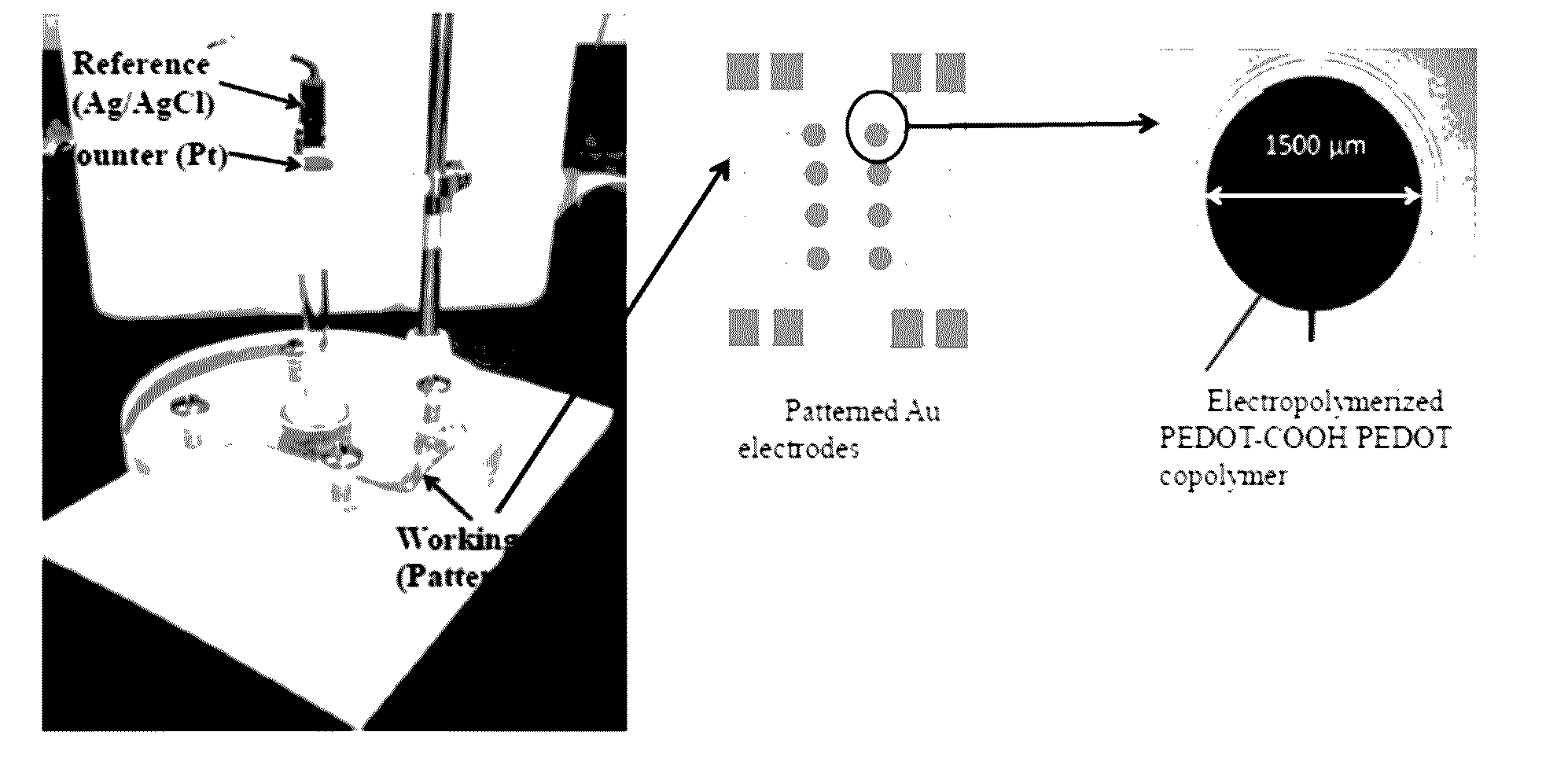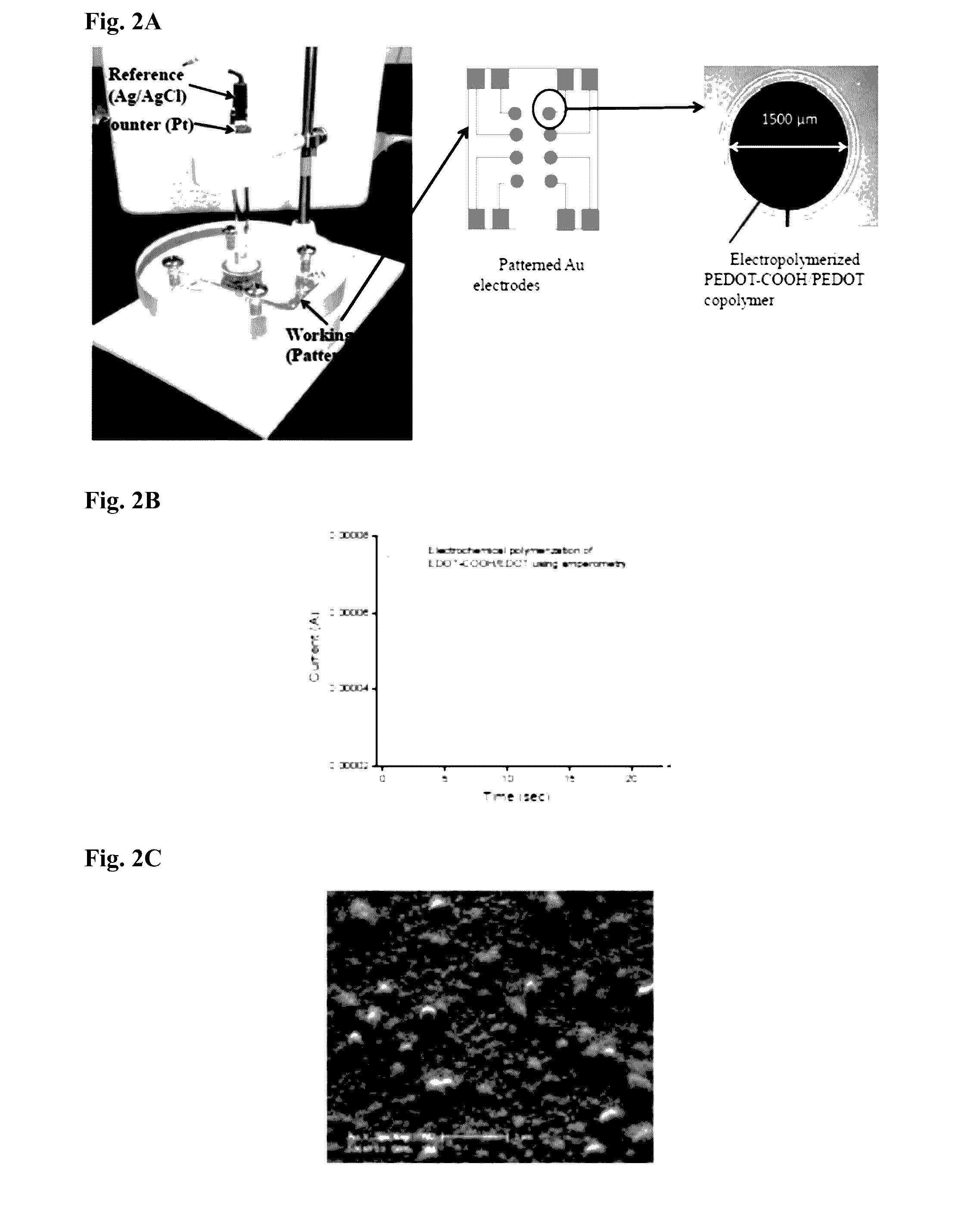Conductive hydrogels for affinity sensing
- Summary
- Abstract
- Description
- Claims
- Application Information
AI Technical Summary
Benefits of technology
Problems solved by technology
Method used
Image
Examples
example 1
Preparation of PEDOT-PEG Hydrogel
[0106]We constructed a novel composite conducting hydrogel constituting conductive carboxyl-functionalized PEDOT and a high molecular weight PEG for development of an immunosensor. The carboxyl functionality provides capability of bioconjugation. The bio-interfaces were prepared by polymerizing PEG on top of miniaturized Au electrodes followed by electro-polymerizing PEDOT copolymer into the porous PEG gel using aqueous microemulsion. The PEDOT / PEG copolymer was compositionally tunable and controlled to deposit on an array of electrode surfaces. The COOH groups present on the conducting polymer chain were tailored with B-IFN-γ antibodies via active ester groups. The antibody immobilized conducting hydrogel electrodes were utilized for label-free electrochemical detection of B-IFN-γ in buffer and bovine plasma. Binding of B-IFN-γ to antibody results in electrochemical signal decrease caused due hindrance of electron transfer. This signal-off sensing m...
example 2
Preparation of Sensor
[0115]Gold and ITO patterned electrodes were prepared using photolithography and wet-etching approaches as previously reported. The micropatterned glass slides, containing photoresist on top of Au surface, were treated with oxygen plasma for 10 min and incubated in 0.05% solution of (3-acryloxypropyl) trichlorosilane in toluene for about one hour under nitrogen atmosphere to obtain a self-assembled monolayer of silane on the glass regions. The procedure is described in more detail below.
[0116]Positive resist (S1813) was spin-coated (2000 rpm for 30 sec) on glass slides coated with 15 nm Cr adhesion layer and 100 nm Au layer resulting in formation of a thick layer of photoresist. The photoresist-coated glass slides were soft-baked on a hot-plate at 115° C. for 1 min, then placed in contact with a photomask and exposed to 365 nm UV source. The substrates were then placed into a developer solution (MF 319). After development step, Au-coated glass slides were immers...
example 3
Detection of Tuberculosis
[0119]The antibody (bovine-IFN-γ) functionalized PEDOT conducting hydrogel was placed in the electrochemical cell set up of Example 2. Different concentrations of target (recombinant interferon gamma) prepared in 1×PBS were introduced into the electrochemical cell and incubated for about 20 mins. The cyclic voltamograms were recorded.
[0120]Each sensing electrode (antibody functionalized conductive hydrogel on Au microelectrode) was connected to potentiostat via Au contact pads as shown in FIG. 8A. Each sensing electrodes was individually addressed by potentiostat in this way.
[0121]The Au electrodes having conductive gel on the sensing chip were working electrodes and were individually addressed by potentiaostat. We used external Ag / AgCl reference and platinum wire counter electrodes. These were dipped in the lectrolyte solution of the electrochemical cell set up as shown in Fig. and were connected to potentiostat.
[0122]To test the specificity of the conducti...
PUM
 Login to View More
Login to View More Abstract
Description
Claims
Application Information
 Login to View More
Login to View More - R&D
- Intellectual Property
- Life Sciences
- Materials
- Tech Scout
- Unparalleled Data Quality
- Higher Quality Content
- 60% Fewer Hallucinations
Browse by: Latest US Patents, China's latest patents, Technical Efficacy Thesaurus, Application Domain, Technology Topic, Popular Technical Reports.
© 2025 PatSnap. All rights reserved.Legal|Privacy policy|Modern Slavery Act Transparency Statement|Sitemap|About US| Contact US: help@patsnap.com



